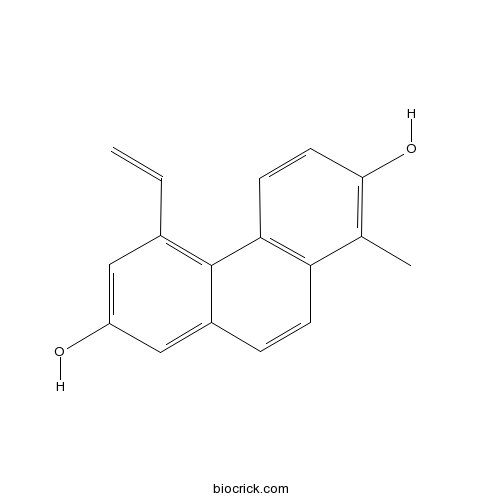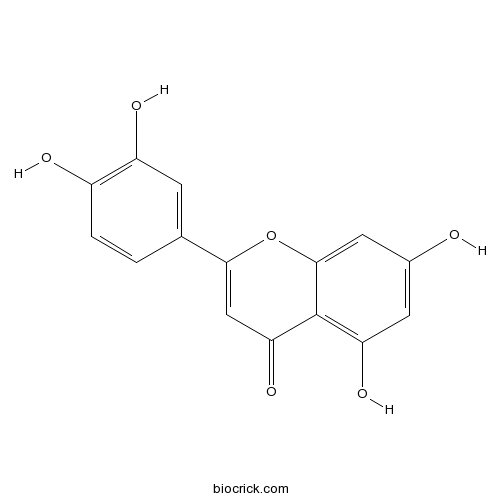Juncus effusus
Juncus effusus
1. The products in our compound library are selected from thousands of unique natural products; 2. It has the characteristics of diverse structure, diverse sources and wide coverage of activities; 3. Provide information on the activity of products from major journals, patents and research reports around the world, providing theoretical direction and research basis for further research and screening; 4. Free combination according to the type, source, target and disease of natural product; 5. The compound powder is placed in a covered tube and then discharged into a 10 x 10 cryostat; 6. Transport in ice pack or dry ice pack. Please store it at -20 °C as soon as possible after receiving the product, and use it as soon as possible after opening.
Natural products/compounds from Juncus effusus
- Cat.No. Product Name CAS Number COA
-
BCN2927
Dehydroeffusol137319-34-7
Instructions

-
BCN5600
Luteolin491-70-3
Instructions

-
BCN5388
Luteolin-7-O-glucoside5373-11-5
Instructions

-
BCN1209
Eriodictyol552-58-9
Instructions

-
BCN2926
Juncusol62023-90-9
Instructions

-
BCN2928
Effusol73166-28-6
Instructions

Shotgun Proteomics and Quantitative Pathway Analysis of the Mechanisms of Action of Dehydroeffusol, a Bioactive Phytochemical with Anticancer Activity from Juncus effusus.[Pubmed: 29812950]
Dehydroeffusol (DHE) is a phenanthrene isolated from the Chinese medicinal plant Juncus effusus. Biological evaluation of DHE reveals in vitro and in vivo anticancer effects. We performed a shotgun proteomic analysis using liquid chromatography-tandem mass spectrometry to investigate the changes in the protein profiles in cancer cells upon DHE treatment. DHE affected cancer-associated signaling pathways, including NF-κB, β-catenin, and endoplasmic reticulum stress. Through quantitative pathway and key node analysis of the proteomics data, activating transcription factor 2 (ATF-2) and c-Jun kinase (JNK) were found to be the key components in DHE's modulated biological pathways. Based on the pathway analysis as well as chemical similarity to estradiol, DHE is proposed to be a phytoestrogen. The proteomic, bioinformatic, and chemoinformatic analyses were further verified with individual cell-based experiments. Our study demonstrates a workflow for identifying the mechanisms of action of DHE through shotgun proteomic analysis.
The interaction of heavy metals and metalloids in the soil-plant system in the São Domingos mining area (Iberian Pyrite Belt, Portugal).[Pubmed: 29752668]
São Domingos belongs among the most important historic Iberian Pyrite Belt Cu mines. The anthrosoil is contaminated by a very high content of heavy metals and metalloids. The study was focused on evaluating the interaction of some chemical elements (Ca, Mg, Fe, Mn, Cu, Pb, Zn, Ag, Cd, Ni, Co, As, Sb) in the system soil vs. five autochthonous dominant plant species: Pinus pinaster Aiton, Quercus rotundifolia Lam., Agrostis sp., Juncus conglomeratus L. and Juncus effusus L. The plants are heavily contaminated by Cu, Pb, As and Zn. The bioconcentration factor proved that they exhibit features of metal tolerant excluders. The trees are accumulators of Ag, whereas the graminoids are hyper-accumulators of Ag and Juncus effusus of Co. The translocation factor confirmed that the selected elements are immobilised in the roots except for Mn and Zn in Pinus pinaster and Mn in Quercus rotundifolia and Juncus conglomeratus. The bioaccumulation of Mn, Zn and Cu at low pH increases. The increased content of Ca and Mg in the soil inhibits, in the case of some metals and metalloids, their intake to plants. Although the studied plants, despite their fitness and vitality at the contaminated sites, are not suitable for phytoextraction (except Co and Ag), they can be used for phytostabilisation at the mining habitats.
Stress Responses of Aquatic Plants to Silver Nanoparticles.[Pubmed: 29381864]
Silver nanoparticles (AgNPs) are increasingly used in consumer products, biotechnology, and medicine, and are released into aquatic ecosystems through wastewater discharge. This study investigated the phytotoxicity of AgNPs to aquatic plants, Egeria densa and Juncus effusus by measuring physiologic and enzymatic responses to AgNP exposure under three release scenarios: two chronic (8.7 mg, weekly) exposures to either zerovalent AgNPs or sulfidized silver nanoparticles; and a pulsed (450 mg, one-time) exposure to zerovalent AgNPs. Plant enzymatic and biochemical stress responses were assessed using superoxide dismutase (SOD) and peroxidase (POD) activity, malondialdehyde (MDA) concentrations and chlorophyll content as markers of defense and phytotoxicity, respectively. The high initial pulse treatment resulted in rapid changes in physiological characteristics and silver concentration in plant tissue at the beginning of each AgNPs exposure (6 h, 36 h, and 9 days), while continuous AgNP and sulfidized AgNP chronic treatments gave delayed responses. Both E. densa and J. effusus enhanced their tolerance to AgNPs toxicity by increasing POD and SOD activities to scavenge free radicals but at different growth phases. Chlorophyll did not change. After AgNPs exposure, MDA, an index of membrane damage, was higher in submerged E. densa than emergent J. effusus, which suggested that engineered nanoparticles exerted more stress to submerged macrophytes.
Distribution and transfer of potentially toxic metal(loid)s in Juncus effusus from the indigenous zinc smelting area, northwest region of Guizhou Province, China.[Pubmed: 29367113]
We collected samples (i.e., the aerial parts and roots of Juncus effusus and their growth media) in the indigenous zinc smelting area in the northwest region of Guizhou Province, China, and we measured and analyzed potentially toxic metal(loid)s (arsenic, As; cadmium, Cd; chromium, Cr; copper, Cu; mercury, Hg; lead, Pb and zinc, Zn) in these samples. The results include the following: First, there is a high concentration of one or more potentially toxic metal(loid)s in the slag and surrounding soil in the research area. This situation might be caused by metal(loid) damage or contamination due to the circumstances. Additionally, Juncus effusus in the indigenous zinc smelting area are contaminated by some potentially toxic metal(loid)s; since they are used for Chinese medical materials, it is especially significant that their As, Cd and Pb concentrations are greater than their limited standard values. Finally, both the bioconcentration factors and transfer factors for most potentially toxic metal(loid)s in Juncus effusus are less than 1 in the study area. Therefore, we suggest that Juncus effusus could be used for phytostabilization or as a pioneer plant for phytoremediation of potentially toxic metal(loid)s because it has a tolerance and exclusion mechanism for these metal(loid)s in the research district.
The sulfur depot in the rhizosphere of a common wetland plant, Juncus effusus, can support long-term dynamics of inorganic sulfur transformations.[Pubmed: 28605708]
The sulfur cycle in the rhizosphere of constructed wetlands is frequently interlaced with transformations of carbon and nitrogen. Knowledge about the manifold sulfur transformations may thus aid in improving treatment performance of constructed wetlands. In this study, two laboratory-scale constructed wetland models (planted fixed bed reactors; PFR1 and PFR2) were used to investigate inorganic sulfur transformations at various total loads of sulfate and organic carbon. Sulfate, sulfide and elemental sulfur were the most abundant sulfur compounds detected, thus providing evidence for the simultaneous occurrence of dissimilatory sulfate reduction and sulfide oxidation. This co-occurrence was likely enabled by oxygen micro-gradients in the root-near environment, i.e. aerobic sulfide and elemental sulfur oxidation took place mostly at the roots while sulfate and elemental sulfur reduction occurred in the pore water under reduced redox conditions. The rhizosphere was found to be first sink, then source for sulfur during the course of the experiment. Immobilization of reduced sulfur was triggered by catabolism of organic matter coupled to dissimilatory sulfate reduction and the subsequent partial oxidation of generated sulfide. Good plant status was critical for sulfur deposition in the systems. Without externally provided sulfate the sulfur depot of the rhizosphere was a prolonged source for sulfur, which was remobilized into the pore water. Oscillations between sulfide and sulfur (PFR1) or sulfide and sulfate (PFR2) suggested a dynamic interplay between plants and various microbial guilds, i.e. dissimilatory sulfate and sulfur reducers on one side and sulfide and sulfur oxidizers on the other.
Characterization of a novel natural cellulosic fiber from Juncus effusus L.[Pubmed: 28578950]
This study aims to assess the morphology and properties of fibers extracted from a wild natural plant largely available in Algeria known as Juncus effusus L. (JE). The morphology and diameter of the fiber bundles extracted from the stem of the JE plant were characterized by optical and scanning electron microscopy. The functional groups of the extracted lignocellulosic JE fibers were studied by FTIR, their thermal degradation behavior was investigated by TGA and their crystallinity was determined using X-ray diffraction technique. In addition, mechanical characterization was carried out using tensile tests on the lignocellulosic fiber in order to evaluate their strength, strain at break and Young's modulus. In view of the dispersion in the obtained experimental results, the latter were analyzed using the Weibull statistical laws with two and three parameters.


